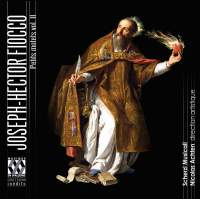Texte paru dans: / Appeared in: Musique en Wallonie |
|
|
Outil de traduction ~ (Très approximatif) |
|
|
Reviewer: Bertil
van Boer Joseph-Hector Fiocco (1703–1741) is one of those early 18th-century composers who has lain by the wayside of the mainstream as the Baroque and early Classical period transitioned. It was probably because the city of Brussels, under the Hapsburg domain, was seen mostly as an outpost, where both musicians and performers passed through en route to the musical centers such as Paris and Amsterdam, or the Court of Lorraine in Liège. Yet, the governors of the city often employed and imported excellent musicians, resulting in a vibrant musical life. One of these employed the Pietro Antonio Fiocco, who came from Italy to oversee the Theâtre de la Monnaie. The family settled there permanently, and his son Joseph-Hector followed in his father’s footsteps in the court musical ensemble beginning in 1729. A brief stint in Antwerp followed, where he devoted his time to the composition of sacred music for the cathedral, but by 1737 he was back in Brussels as a church maître de chappelle, a post he retained until an early death. Known mainly for his sets of keyboard works, Fiocco nonetheless devoted much energy to a wide variety of church music. Whereas the former gained him a considerable reputation among Parisian notables such as Jean-Philippe Rameau, the latter were mostly for local consumption, though a number of works eventually wound up being performed at the Concerts Spirituels during the early years of its existence. Unfortunately, much of his music has not survived due to fire and war, but the 22 motets are masterworks of the genre. The vocal writing is mainly four-part and homophonic, with short, pithy phrases and a meandering violin part (often both violins in unison and a viola part that often doubles the bass line at the octave). This is the second volume of “petits motets,” containing six of these four-movement works. It is clearly a project by the state-funded Musique en Wallonie to record a complete selection of the surviving works. While I have not heard the first volume, I can say that the music of this second one is superb. It may not be as progressive as, say, late Telemann, but the sonorities and part-writing harken more to the Classical style than the Baroque, even though the highly active accompaniment is a remnant of the earlier era. A couple of examples should suffice to give one a sense of this transitionary style. In the Laudate pueri the first movement is deliberately old-fashioned in the spinning out of the main theme in the first movement, with the oboe doubling the wandering violin line. The soprano solo serves as the perfect foil with a longer lyrical line. In “A solis ortu” the softer flute has an extensive introduction that is in a more empfindamer Stil, sounding much like the work of C. P. E. Bach or the Berlin School. The soprano line simply soars in graceful arches, emerging from the flute accompaniment at times with clarity and grace. An emotional arioso and recitative leads directly into the “Suscitans a terra” which is formed around a minuet meter and rocking violins that sound almost Vivaldian. The final “Alleluja” is more modern, with a swirling oboe line and quite virtuoso vocal line. Here the joy is infectious. If this had been written by Handel, Telemann, or Vivaldi, it would be on everyone’s repertory list, and there is more than a bit of forward-looking style that hints at the Classical period just around the corner. In contrast, one might look at the Exaudiat te Dominum, where the imitative opening is carried on into the vocal entrances of both tenors, all above a steady walking bass. The former play off against each other throughout the opening movement. The aria “Mittat tibi auxilium” weaves both solo violins and tenor solo in a perfect musical ménage a trois. The next aria, “Lætabimur in salutary tuo,” is positively Handelian, with the violins relegated to the function of the ritornello against the tenor, and a steady bass holding it all together. Vivaldi makes his appearance in the suspensive “Impleat Dominus,” leading directly into the final movement, “Exaudiet illum,” which returns a steady, lilting duet right up to the imitative doxology.
The
performance by the group Scherzi Musicali is top-rate. The tempos give this
solemn music power and gravitas. The playing of the instrumental ensemble
has excellent intonation and they demonstrate a good flexibility with this
style of music. Under their deft hands Fiocco comes alive. Now, I have to
get not only the first volume but also wait with anticipation for the third.
Well worth exploring for how progressive music could be during this
transitionary period. | |
|
Support us financially by purchasing this disc from eiher one of these suppliers. Un achat via l'un ou l'autre des fournisseurs proposés contribue à défrayer les coûts d'exploitation de ce site. |
|
|
|
|
|
Cliquez l'un ou l'autre
bouton pour découvrir bien d'autres critiques de CD |
|




